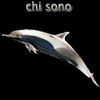
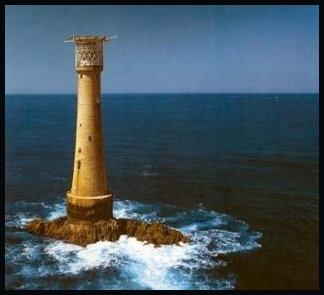


|
|
|
|||||||||||||||||||
|
|
||||||||||||||||||||
|
|
I FARI NEL MONDO THE LIGHTOUSE OF LIVORNO by Annamaria "Lilla" Mariotti Articolo pubblicato dalla rivista americana THE KEEPER'S LOG edita a Hansville, Stato di Washington, USA, nel mese di Maggio 2010 (Segue testo originale)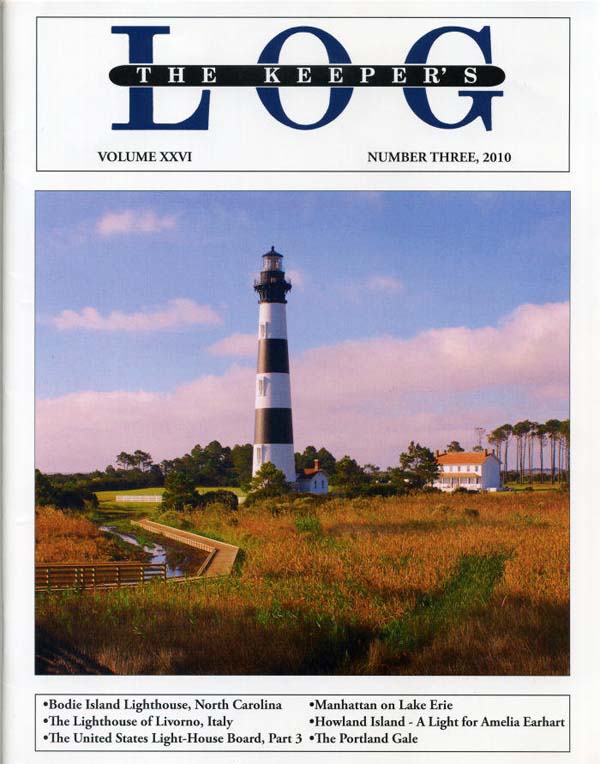 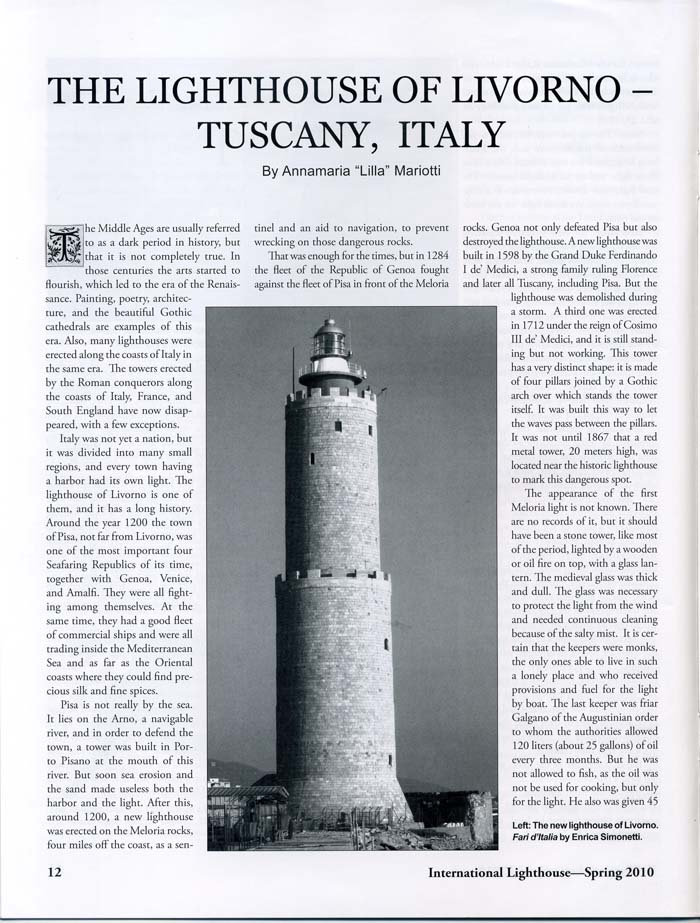 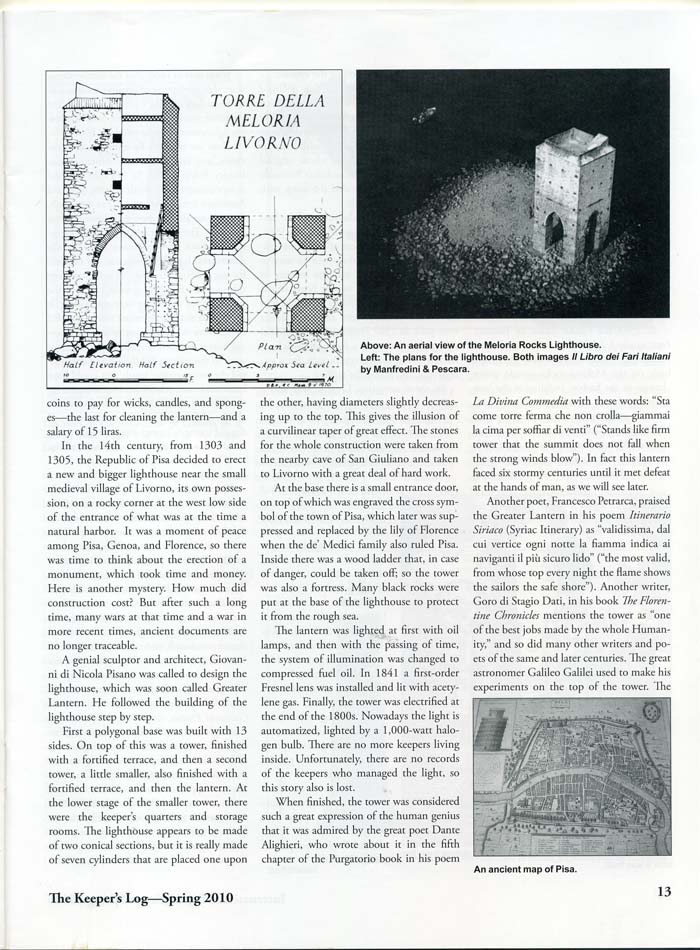  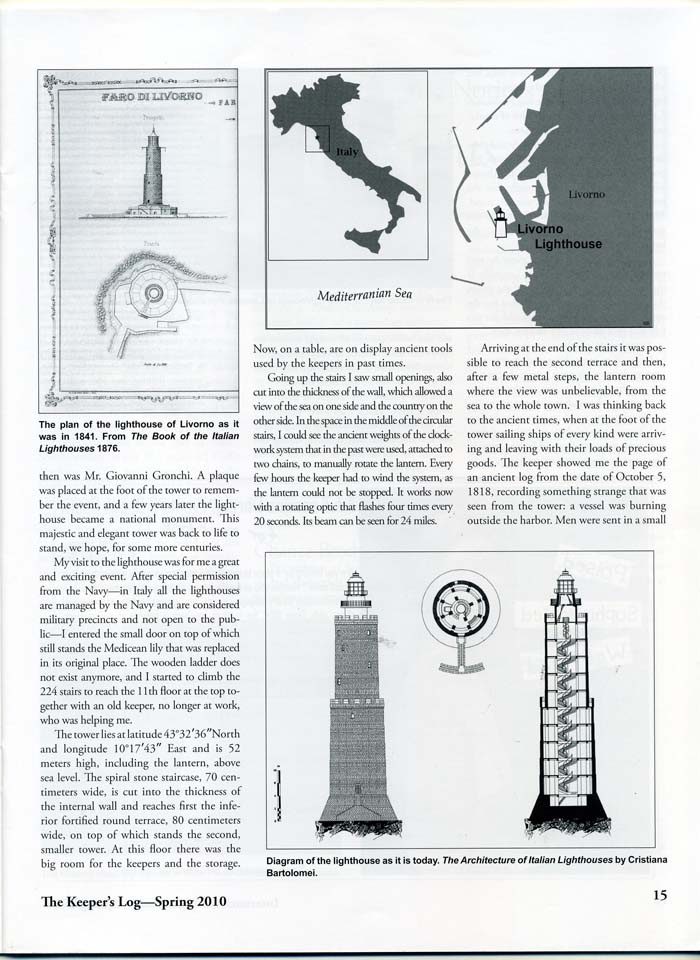 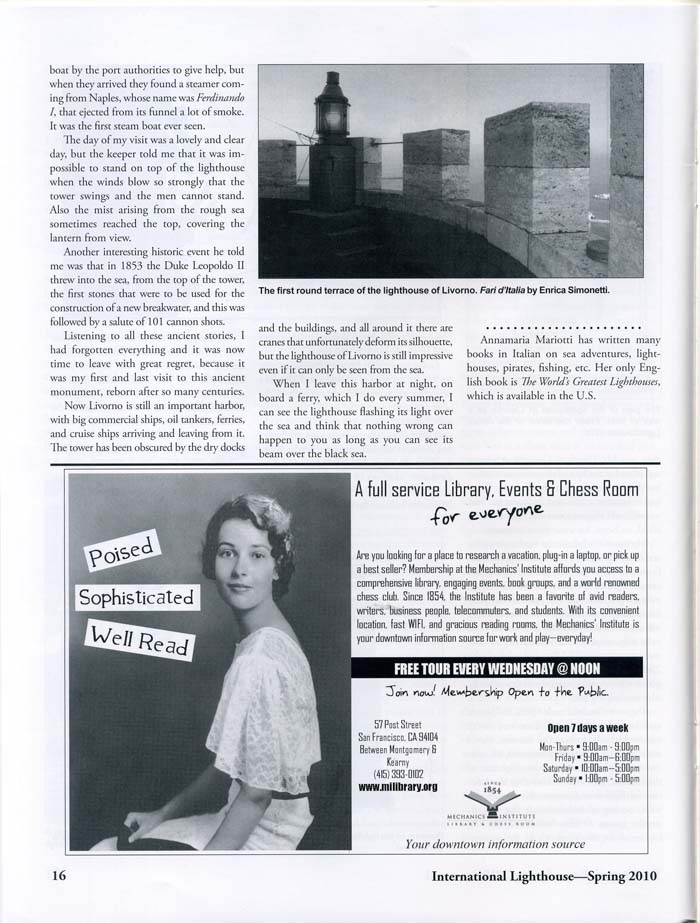 THE LIGHTHOUSE OF LIVORNO, TUSCANY - ITALY by Annamaria "Lilla" Mariotti (Testo originale) It is usual to say that the Middle Age has been a dark period in history, but that it is not completely true. In those centuries started to flourish the arts which will led to the era of the Renaissance : painting, poetry, architecture, the beautiful Gothic cathedrals are an example, and also many lighthouses were erected along the coasts of Italy in the same era. The towers erected by the Roman conquerors along the coasts of Italy, France and South England by this time were all disappeared, with a few exceptions. Italy was not yet a nation, but was divided into many small reigns and every town having a harbor has its own light. The lighthouse of Livorno is one of them and it has a long story. Around 1200 the town of Pisa, not far from Livorno, was one of the most important four Seafaring Republic of its time, together with Genoa, Venice and Amalfi and were all fighting among them. In the meantime they had a god fleet of commercial ships and were all trading inside the Mediterranean sea and as far as the oriental coasts were they could find the precious silk and fine spices. Pisa is not really by the sea, it lies on the Arno, a navigable river, and in order to defend the town a tower was built in Porto Pisano, at the mouth of this river, but soon the sea erosion and the sand made useless both the harbor and the light. After this, in around 1200, a new lighthouse was erected on the Meloria rocks, four miles off the coast as a sentinel and an aid to navigation, to prevent wrecking on those dangerous rocks. That was enough for the times, but in 1284 the fleet of the Republic of Genoa fought against the fleet of Pisa in front of the Meloria rocks and Genoa not only defeated Pisa, but also destroyed the lighthouse. A new one was rebuilt a first time in 1598 by the Grand Duke Ferdinando I de’ Medici, a strong family ruling Florence and later all Tuscany, including Pisa, but was demolished during a storm. A third one was erected only in 1712 under the reign of Cosimo III de’ Medici and it is still standing but not working. This tower has a very particular shape, it is made of four pillars joined by a gothic arc over which stands the tower itself. It was built in this way to let the waves pass in between the pillars. It was not until 1867 that a red metal tower, 20 meters high, was located near the historic lighthouse to sign this dangerous spot. It is not known which the aspect of the first Meloria light was, there are no records of it, but it should have been a stone tower, like most of the period, lighted by a wooden or oil fire on top, with a glass lantern. The medieval glass was thick and dull, but it was necessary to protect the light from the wind and needed continuous cleaning because of the salty mist. It is certain that the keepers were monks, the only ones able to live in such a lonely place, who received provisions and fuel for the light by boat. The last keeper was friar Galgano of the Augustinian order to whom the authorities allowed 120 liters (about 25 gallons) of oil every three months – but he was not allowed to fish, the oil should not be used for cooking, but only for the light – 45 coins to pay for wicks, candles and sponges – the last for cleaning the lantern – and a salary of 15 liras. In the XIV century, from 1303 and 1305, the Republic of Pisa decided to erect a new and bigger lighthouse near the small medieval village of Livorno, its own possession, on a rocky corner at the west low side of the entrance of what was at the time natural harbor. It was a moment of peace among Pisa, Genoa and Florence, so there was time to think to the erection of a monument who took time and money. Here is another mystery, how much it was paid for the construction, but after such a long time, many wars at that time and a war in more recent times, so ancient documents are no more traceable. A genial sculptor and architect, Giovanni di Nicola Pisano was called to draw the plan of the lighthouse, which was soon called Greater Lantern, and followed the building step by step. First was built a polygonal base having thirteen sides and on top of this a first tower, finishing with an embattled terrace, and then a second tower, a little smaller, also finishing with an embattled terrace and then the lantern. At the lower stage of the smaller tower there were the keeper’s quarters and storage rooms. The lighthouse appears made of two conical sections, but it is really made of seven cylinders that are fairly superimposed one upon the other, having diameters slightly decreasing till the summit. This gives to the whole the illusion of a curvilinear taper of great effect. The stones for the whole constructions were taken from the nearby cave of San Giuliano and taken to Livorno with great hard work. At the base there is a small entrance door on top of which was engraved the cross symbol of the town of Pisa, which later was suppressed and replaced by the lily of Florence when the de’ Medici family ruled also Pisa. Inside there was a wood ladder that, in case of danger, could be taken off, so the tower was also a fortress. Many black rocks were put at the base of the lighthouse to protect it from the rough sea. The lantern was lighted at first with oil lamps, then with the passing of the time, changed the fuel and the system of illumination into compressed fuel oil, to arrive in 1841 to the first order Fresnel Lens working with acetylene fumes, until the tower was electrified at the end of the 1800s. Nowadays the light is automatized, is lighted by a 1000 Watt halogen bulb and there are no more keepers living inside. Unfortunately there are no records of the keepers who managed the light, also this story is lost. When finished the tower was considered such a great expression of the human genius that was admired by the great poet Dante Alighieri who could not do without writing of it in the V° chapter of the Purgatorio book of his poem “LA DIVINA COMMEDIA” with these words: “ Sta come torre ferma che non crolla – giammai la cima per soffiar di venti” (“Stands like firm tower that the summit does not fall when the strong winds blow”). In fact this lantern faced six stormy centuries until the men did not defeat it, but we will see it later. Another poet, Francesco Petrarca, praised the greater lantern in his poem “ITINERARIO SIRIACO” (Syriac Itinerary) as “validissima, dal cui vertice ogni notte la fiamma indica ai naviganti il più sicuro lido” (“The most valid, from whose top every night the flame shows the sailors the safe shore”). Another writer, Goro di Stagio Dati, into his book “THE FLOENTINE CRONICLES” mentions the tower as “one of the best job made by the whole Umanity” and so did many other writers and poets of the same century and over. The great astronomer Galileo Galilei used to make his experiments on the top of the tower. The lighthouse of Livorno was also impressed in some golden coins, still preserved in the Civic Museum of Pisa. Pisa started again to fight, first with Genoa, and it was around 1406 that the town lost his power as a Seafaring Republic, after a war with Florence, and became e possession of the de’ Medici family who bought the town and the harbor for the amount of 100.000 florins. Cosimo I de’ Medici, a great ruler, realized that Livorno was in a strategic position to become e very important channel of trade into the Mediterranean sea for Florence, which was inland, and was a growing town expanding its traffic all around d the known world. So he ordered many works in the harbor to make it more efficient. And the lighthouse was still standing. In 1583 the Grand Duke of Tuscany, Ferdinando I de’ Medici - that as we have been already see had ordered a new lighthouse on the Meloria rocks - made major changes in the harbor, with the building, at the base of the lighthouse, of a docky yard, the first for the time, and a quarantine station for the seamen coming from the Mediterranean and Oriental coasts where there could have been epidemic diseases. It is said that the job was made only in five days, because five thousand men were put at work. Anyway this changed the aspect of the lighthouse which was now covered at the base by the new buildings, which were still standing by the early 1900, but now are all disappeared. The development of the harbor went together with a major town-planning of Livorno, whose original plant was designed by the architect Bernardo Buontalenti, who encircled the town with pentagonal shaped walls. A major change in the traffic of the harbor was made by a law of March 16, 1565 to control the maritime custom. The leaving ships had to stay in line along the wharf and the loading of the goods were made by smaller boats whose load were strictly controlled by the custom authorities to make them to pay the right duties. In 1587 Ferdinando I° de’ Medici changed Livorno into a free port, which called many commercial vessels from everywhere increasing the traffics. In these centuries Livorno was also a military harbor, and the lighthouse saw the medicean galleys leaving to chase into the Mediterranean sea the dangerous Saracen pirate ships that in these centuries were attacking and plundering the Italian coasts. At the expiring of the de’ Medici family, in 1736, Livorno had obtained the qualification of town and had more than thirty thousand inhabitants a great harbor and a lighthouse that was the oldest along the coasts of Italy, older than the tower of Genoa, built in 1543. In 1737 the dynasty of Lorena started to rule Tuscany. The first of them was the Grand Duke Francesco I, who increased the harbor, which attracted ships from everywhere and become more and more a strong trade center both for goods in transit and storing owing to his security given also by its lighthouse. This dynasty ruled for more than a century, during which the town was occupied by the French, the Spanish and the English troops, but anyway survived. It was only in 1860, after the independence wars, that the history of Livorno become part of the history of Italy, e new born nation, and the tower was inserted into the list of the Italian lighthouses with the number 1896. Now we have to fly through the centuries, and arrive at a sad moment of our history. It was the time of WWII, in 1943 the German troops occupied the north of Italy, while the American armies came up from the South. Rome was already free and Florence was near. The harbor and the town of Livorno had been bombed may times by the Americans, but the lighthouse did not suffer any damage, anyway its light had been extinguished since long time to avoid the possibility of a landing near the harbor. Came time that the German troops decided to flee from the Americans which were nearer, but before this they made to the ancient lighthouse the most terrible insult that could have been made to so an ancient monument: on July 19, 1944 they destroyed it with a charge of dynamite to the foundations and the old tower collapsed. It had faced for centuries, storms, different rulers, any kind of offence coming from the nature, but a in a short time a group of man cancelled all this. The ruins were left at its place, nobody wanted to remove them, until in the mid 1900s when the population of Livorno wanted again its lighthouse, not a new one, but ”their lighthouse”. The chairman of the local Chamber of Commerce and Industry of Livorno, Mr. Graziani, in 1952 opened a public subscription that in short time reached 2 million lira, a lot of money for the time, for the reconstruction and more were found. The work started in June 1954, ten years after the destruction, and the job was carried by the Ghezzani company which, with great faith in what they were doing, followed the original plans of 1303 of Giovanni Pisano, employing the 90% of the original material and when missing, using new stones taken from the original cave of San Giuliano. In two years the tower was ready and the new lighthouse of Livorno had the same aspect of the old one. It was a miracle: on September 16, 1956 there was the great opening of the lighthouse at the presence of the whole population as well as the higher Italian Authorities, among them the President of the Republic who then was Mr. Giovanni Gronchi. A plate was placed at the foot of the tower to remember the event and a few years later it became a National Monument. This majestic and elegant tower was back to life to afford, we hope, some more centuries. My visit to the lighthouse was for me a great and exciting event. After a special permission of the Navy – in Italy all the lighthouses, managed by the Navy, are considered military precincts and not opened to the public – I entered the small door on top of which still stands the Medicean lily that was replaced in its original place. The wooden ladder does not exist anymore and I started to climb the 224 stairs to reach the eleven floor to the top together with an old keeper, no more at work, that was helping me. The tower is built in latitude. 43°32’36” north and longitude 10°17’43” east, and is 52 meters high, including the lantern, on the sea level. The spiral stone staircase, 70 centimeters wide is cut into the thickness of the internal wall and reaches first the inferior embattled round terrace, eighty centimeters wide, on top of which stands the second, smaller tower. At this floor there was the big room for the keepers and the storage. Now, on a table, are on display ancient tools used by the keepers in past times. Going up to the stairs I saw small openings, also cut into the thickness of the wall, which allowed the view of the sea from one side and the country on the other side. In the space in the middle of the circular stairs I could see the ancient weights of the clockwork system that in the past were used, attached to two chains, to rotate manually the lantern. Were the keeper that every few hours had to charge the system, the lantern could not be stopped. It works now with a rotating optics which flashes four times every twenty seconds and its beam can see for 24 miles. Arriving at the end of the stairs it was possible to reach the second terrace and then, after a few metal steps, the lantern room where the view was unbelievable and arrived from the sea to the whole town. I was thinking to the ancient times, when at the foot of the tower sailing ships of every kind were arriving and leaving, with their load of precious goods. The keeper showed me the page of an ancient log at the date of October 5, 1818 recording something strange that was seen from the tower: a vessel was burning out of the harbor. Men were sent into a small boat by the port authorities to give help, but when they arrived they found a steamer coming from Naples, whose name was “Ferdinando I°”, that ejected from its funnel a lot of smoke. It was the first steam boat never seen. The day of my visit was a lovely and clear day, bur the keeper told me that it was impossible to stand on top of the lighthouse when the winds blow so strongly that the tower swings and the men cannot stand. Also the mist arising from the rough sea sometimes reached the top, covering the lantern to the view. Another interesting historic event he told me was that in 1853 the Duke Leopoldo II threw into the sea from the high of the tower the first stones which were to be used for the construction of a new breakwater, and this was followed by a salute of 101 cannon-shots. Listening to all this ancient stories I had forgotten everything and it was now time to leave with great regret, because it was my first and last visit to this ancient monument, reborn after so many centuries. Now Livorno is still an important harbor, big commercial ship, oil tankers. ferries and cruise ships land and leave from it and the tower has been absorbed by the dry docks and the buildings, all around it there are cranes that unfortunately deform its silhouette, but the lighthouse of Livorno is still impressive even if it can see only from the sea. When I leave this harbor at night, boarded on a ferry, what I do every summer, I can see the lighthouse flashing its light over the sea and think that nothing wrong can happen to you until you can see its beam over the black sea.
|
|
|
|
||
| Site Map |

